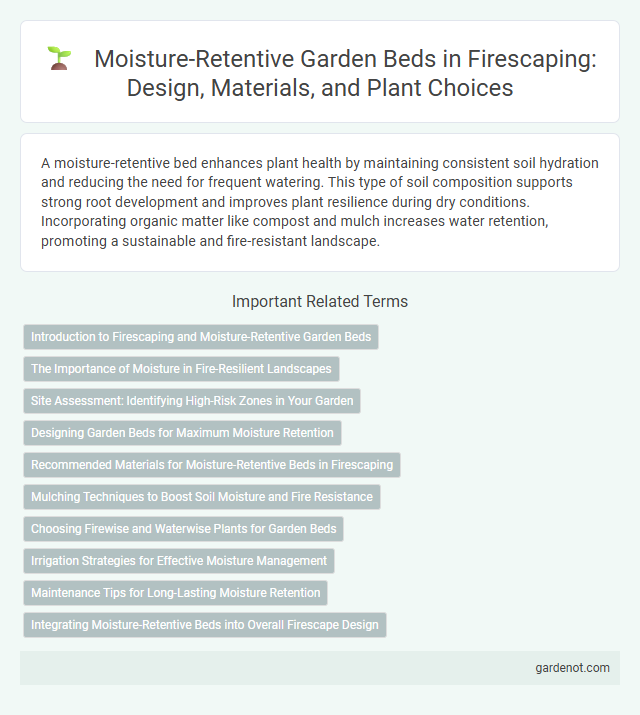A moisture-retentive bed enhances plant health by maintaining consistent soil hydration and reducing the need for frequent watering. This type of soil composition supports strong root development and improves plant resilience during dry conditions. Incorporating organic matter like compost and mulch increases water retention, promoting a sustainable and fire-resistant landscape.
Introduction to Firescaping and Moisture-Retentive Garden Beds
Firescaping incorporates moisture-retentive garden beds to enhance fire resistance by maintaining higher soil moisture levels, which reduce the likelihood of ignition. These beds utilize organic mulches and hydrogels that improve water retention, creating a damp barrier around plants and minimizing dry, flammable material. Incorporating drought-tolerant native plants alongside moisture-retentive techniques optimizes landscape resiliency in fire-prone areas.
The Importance of Moisture in Fire-Resilient Landscapes
Moisture-retentive beds enhance fire-resilient landscapes by maintaining higher soil moisture levels, which slow down the ignition and spread of wildfires. Incorporating organic mulches and water-absorbing soil amendments improves moisture retention, creating a barrier against rapid fire progression. Properly hydrated plants in these beds also resist burning, reducing fuel availability and safeguarding property.
Site Assessment: Identifying High-Risk Zones in Your Garden
Moisture-retentive beds create microhabitats that increase fire risk by retaining dampness that can promote dense vegetation growth, serving as potential fuel sources. Site assessment involves mapping soil moisture levels and identifying areas where water accumulates, such as depressions or heavy clay soils, to pinpoint high-risk zones. Understanding these moisture patterns allows for targeted vegetation management and strategic placement of fire-resistant plants to reduce wildfire hazards in your garden.
Designing Garden Beds for Maximum Moisture Retention
Designing garden beds for maximum moisture retention involves using organic mulch layers and incorporating water-absorbing soil amendments such as compost and biochar to enhance hydration. Raised beds with berms and swales can direct and capture rainfall efficiently while preventing runoff. Selecting native, drought-tolerant plants further reduces water loss and supports sustainable moisture management in firescaping landscapes.
Recommended Materials for Moisture-Retentive Beds in Firescaping
Recommended materials for moisture-retentive beds in firescaping include organic mulches like wood chips, bark, and compost, which help retain soil moisture and reduce fire risk by slowing the spread of flames. Incorporating biochar enhances water retention and soil fertility, supporting healthier plant growth in fire-prone areas. Synthetic moisture-retentive gels or hydrogels can also be used to improve soil hydration, especially in arid environments where maintaining moisture levels is critical for fire prevention.
Mulching Techniques to Boost Soil Moisture and Fire Resistance
Mulching techniques such as applying organic mulch layers, like wood chips or bark, create a moisture-retentive bed that enhances soil hydration and supports plant health, reducing fire risk. These mulches act as a barrier to evaporation, maintaining consistent soil moisture levels critical for fire-resistant landscaping. Using mulch also improves soil structure and promotes microbial activity, further increasing the resilience of vegetation to withstand wildfires.
Choosing Firewise and Waterwise Plants for Garden Beds
Selecting Firewise and Waterwise plants for moisture-retentive beds significantly reduces fire risk while conserving water in garden landscapes. Species such as succulents, California fuchsia, and manzanita thrive in moist soils and exhibit low flammability due to high moisture content and minimal volatile oils. Integrating these drought-tolerant, fire-resistant plants enhances garden resilience, promotes sustainable water usage, and supports ecological balance in fire-prone areas.
Irrigation Strategies for Effective Moisture Management
A moisture-retentive bed enhances fire-resistant landscaping by maintaining optimal soil hydration levels to reduce combustible dryness. Implementing drip irrigation systems delivers water directly to plant roots, minimizing evaporation and ensuring consistent moisture retention critical for fire resilience. Scheduled, low-volume watering during early morning or late evening further conserves soil moisture and supports healthy vegetation growth essential for effective firescaping.
Maintenance Tips for Long-Lasting Moisture Retention
A moisture-retentive bed requires regular mulching with organic materials like bark or compost to preserve soil hydration and minimize evaporation. Consistent monitoring of soil moisture levels through moisture meters enables timely irrigation, preventing both overwatering and drying out. Incorporating drought-tolerant plants and improving soil texture with amendments such as vermiculite or coconut coir enhances long-term water retention and resilience in firescaping environments.
Integrating Moisture-Retentive Beds into Overall Firescape Design
Integrating moisture-retentive beds into firescape design enhances landscape resilience by maintaining higher soil moisture levels that reduce fire risk and support healthy plant growth. These beds utilize materials like mulch, compost, and water-retentive polymers to optimize water retention, which creates a natural barrier against ignition and slows the spread of flames. Incorporating moisture-retentive beds strategically around structures and vegetation improves fire defensibility while promoting sustainable, drought-tolerant ecosystems in fire-prone areas.
Moisture-retentive bed Infographic

 gardenot.com
gardenot.com